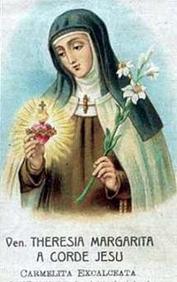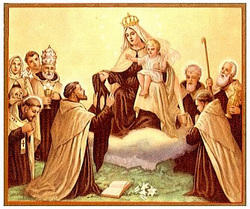Capella delle Reliquie (Chapel of the Holy Relics)
The Capella delle Reliquie or the Chapel of the Holy Relics houses the relics of the saints and blesseds of the Catholic Church under the custody of the Third Order of Carmel. The chapel's patron are two Florentine Carmelite saints: St. Mary Magdalene de Pazzi and St. Teresa Margaret Redi. This chapel is to be erected so that the relics of various saints and blesseds be made available for public veneration upon the request of visiting pilgrims especially those who cannot visit the main shrine of the saint, to revitalize the ancient devotion of Christians to the holy relics and to stress the teaching of the Church on the communion of saints. Hopefully, this chapel would become like that of the Capuchin Franciscan's Relic Chapel, Maria Stein Shrine of the Holy Relics and St. Anthony's Chapel.
The word relic comes from the Latin reliquiae which means "remains". This maybe part of the body or personal effects of the saint or blessed. A reliquary is a shrine that houses one or more relics. For Catholics, relics are important because it helps us in honoring the saints and be connected with them who are heroes of the faith. There are many cures and miracles that are attributed to relics and one of the earliest sources that show the efficacy of relics is found in 2 Kings 13:20-21:
"Elisha died and was buried. Now Moabite raiders used to enter the country every spring. Once while some Israelites were burying a man, suddenly they saw a band of raiders; so they threw the man's body into Elisha's tomb. When the body touched Elisha's bones, the man came to life and stood up on his feet." (NIV)
and a passage in Acts 19:11–12 says that Paul's handkerchiefs were imbued by God with healing power. This shows that the miracles and cures that happen in the presence of the relics. This is not they have powers but rather because of the holiness of the saint they represent since they are transformed by divine grace.
"Elisha died and was buried. Now Moabite raiders used to enter the country every spring. Once while some Israelites were burying a man, suddenly they saw a band of raiders; so they threw the man's body into Elisha's tomb. When the body touched Elisha's bones, the man came to life and stood up on his feet." (NIV)
and a passage in Acts 19:11–12 says that Paul's handkerchiefs were imbued by God with healing power. This shows that the miracles and cures that happen in the presence of the relics. This is not they have powers but rather because of the holiness of the saint they represent since they are transformed by divine grace.
Teaching of the Church on Relics
From the Directory on Popular Piety and the Liturgy (2001)
Congregation for Divine Worship and the Discipline of the Sacraments
236. The Second Vatican Council recalls that "the Saints have been traditionally honoured in the Church, and their authentic relics and images held in veneration"(323). The term "relics of the Saints" principally signifies the bodies - or notable parts of the bodies - of the Saints who, as distinguished members of Christ's mystical Body and as Temples of the Holy Spirit (cf. 1 Cor 3, 16; 6, 19; 2 Cor 6, 16)(324) in virtue of their heroic sanctity, now dwell in Heaven, but who once lived on earth. Objects which belonged to the Saints, such as personal objects, clothes and manuscripts are also considered relics, as are objects which have touched their bodies or tombs such as oils, cloths, and images.
237. The Missale Romanum reaffirms the validity "of placing the relics of the Saints under an altar that is to be dedicated, even when not those of the martyrs"(325). This usage signifies that the sacrifice of the members has its origin in the Sacrifice of the altar (326), as well as symbolising the communion with the Sacrifice of Christ of the entire Church, which is called to witness, event to the point of death, fidelity to her Lord and Spouse.
Many popular usages have been associated with this eminently liturgical cultic expression. The faithful deeply revere the relics of the Saints. An adequate pastoral instruction of the faithful about the use of relics will not overlook:
237. The Missale Romanum reaffirms the validity "of placing the relics of the Saints under an altar that is to be dedicated, even when not those of the martyrs"(325). This usage signifies that the sacrifice of the members has its origin in the Sacrifice of the altar (326), as well as symbolising the communion with the Sacrifice of Christ of the entire Church, which is called to witness, event to the point of death, fidelity to her Lord and Spouse.
Many popular usages have been associated with this eminently liturgical cultic expression. The faithful deeply revere the relics of the Saints. An adequate pastoral instruction of the faithful about the use of relics will not overlook:
- ensuring the authenticity of the relics exposed for the veneration of the faithful; where doubtful relics have been exposed for the veneration of the faithful, they should be discreetly withdrawn with due pastoral prudence(327)
- preventing undue dispersal of relics into small pieces, since such practice is not consonant with due respect for the human body; the liturgical norms stipulate that relics must be "of a sufficient size as make clear that they are parts of the human body"(328)
- admonishing the faithful to resist the temptation to form collections of relics; in the past this practice has had some deplorable consequences
- preventing any possibility of fraud, trafficking(329), or superstition.
Listing of Saints and Blesseds
- Order of the Carmelites of the Ancient Observance ( includes Saint Simon Stock, Saint Mary Magdalene de Pazzi, Blessed Angelo Paoli, etc.)
- Order of Saint Augustine (includes Saint Rita of Cascia, etc.)
- Camaldolese Congregation of the Order of St. Benedict (Saint Romuald)
- Order of Franciscan Minor Capuchin (includes Saint Lawrence of Brindisi, Saint Fidelis of Sigmaringen, etc)
- Congregation of the Blessed Sacrament (Saint Peter Julian Eymard)
- Order of Franciscan Conventual (Saint Joseph of Cupertino)
- Order of the Discalced Carmelites (includes Saint Teresa of Avila, Saint John of the Cross, Saint Therese of Liseux, Blessed Louise and Zelie Martin, Blessed Mary of the Angels, etc.)
- Order of Preachers (Saint Catherine of Siena)
- Order of the Visitation (Saint Margaret Mary Alacoque, etc.)
- Order of the Franciscan Minor (Blessed Claudio Granzotto, etc)
- Missionaries of Charity (Blessed Teresa of Calcutta)
- Opus Dei (Saint Josemaria Escriva de Balaguer)
- Society of Jesus (Blessed Miguel Agustin Pro)
- Order of the Cistercians of Strict Observance (Blessed Maria Sagheddu, etc.)
- Order of Saint Clare (includes Saint Clare of Assisi, Saint Camilla Battista Varano, Saint Veronica Guiliani, etc.)
- Order of Saint Benedict (Blessed Fortunata Viti, etc.)
- Congregation of the Passion of Our Lord Jesus Christ (Saint Paul of the Cross, Saint Gemma Galgani, Saint Maria Gorreti, etc)
- Congregation of the Most Holy Redeemer (St. John Henry Neumann, etc)
- Salesians of Don Bosco (Saint John Bosco, Saint Dominic Savio, etc)
- Rogationists of the Heart of Jesus (Saint Hannibal Marie de Francia)
- Order of the Most Holy Trinity (Blessed Anna Maria Taigi)
- Others (Blessed Anne Catherine Emmerick, Blessed Alberto Marvelli, Saint Hilary of Poiters, Saint Catherine of Alexandria, Saint Arcangelo Tadini, Blessed Francesco and Jacinta Marto, Saint Gianna Beretta Molla, Blessed Maria Domenica Brun Barbantini)





